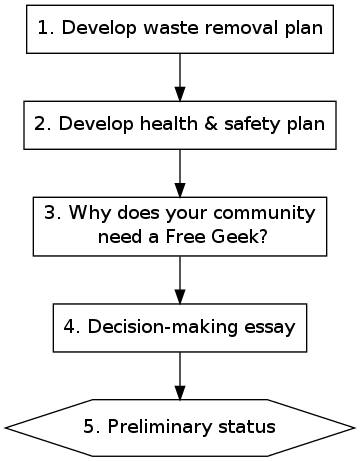Trademark application flow chart
This is a page concerning a policy or procedure in development.
Once fleshed out, we'll consider it for adoption as official policy at Free Geek.
The following chart shows several straightforward steps to be accomplished by the applicant. We should have a paragraph explaining each step and why it is important, and point to resources for accomplishing that step.
I would also state clearly that we expect reporting to the franchise list (or somewhere else if we want) during this process, so we can identify problems as they develop and point people in a useful direction. (Once ongoing status is achieved, regular reporting would continue. But while this process is happening, the reporting would likely be more interactive and less formatted.)
Overview
Caveats:
- untested
- some of these steps could happen in a slightly different order
- not completely decided which steps are optional and which are mandatory
- many things left undefined

Some detailed steps
|
You don't need to use the Free Geek name to do a lot of the great things we're trying to do. But in order to use the name legally you must follow our principles and maintain a level of transparency. And you have to apply to use our trademark. This process is broken down into getting Preliminary status, then Ongoing status, and then maintaining that status. The process summary is as follows.
|
Every object has a number and a detailed description below. The following steps are to be taken in order by a startup. Each step must be completed and found sufficient by the review committee before the next step is begun.

1. Even if your organization's plan is to maximize on reuse (ours is, too) or to focus on software, you will receive electronic waste. Please provide us with a general list of types of electronics that will be accepted and an exhaustive, detailed plan on how they will be dealt with, especially hazardous waste. The list should include but not be limited to: CRTs, motherboards, etc. You DO NOT need to be a recycler, but at this point you need a plan for waste removal. Coming up with a plan for dealing with CRT monitors in a responsible way will be a crucial point here. The greater plan will be the result of considering as many options as possible and going with the most responsible options. Please note, you do not need to be a Free Geek to call around. We recommend getting in touch with the Basel Action Network ( http://www.ban.org ) for some help with that research. Startups that are not interested in or cannot come up with a comprehensive plan for dealing with their e-waste will not make it past this point.
2. Please develop a health & safety plan that will be relevant to your proposed area of service that deals with hazardous waste and the possibility of environmental contamination. For an example, check out our Safety policy.
3. Please explain why your community needs a Free Geek. Please note: in order for your organization to be a Free Geek, it needs to satisfy the Free Geek Principles. As a non-profit, it next satisfies the public will. Staff, volunteers and members of the community will be on equal ground when making decisions. This is called a non-hierarchical system and a group that does not work this way is not a Free Geek.
4. Imagine that you have a lot of volunteers and two of them aren't getting along. One of them has requested that the other be asked to leave the organization. Please outline some possible scenarios through which your organization could handle this request and how does it demonstrate the decision-making program, various committees, if any, that you have in mind to start out with. Please demonstrate that you understand the elements of the decision-making process that are unique to non-hierarchical democracies.
5. If steps one through three have been adequately done, Free Geek will formally grant preliminary status for your startup. The startup must follow the steps outlined in the preliminary status page in order to keep the name, or it will be revoked.